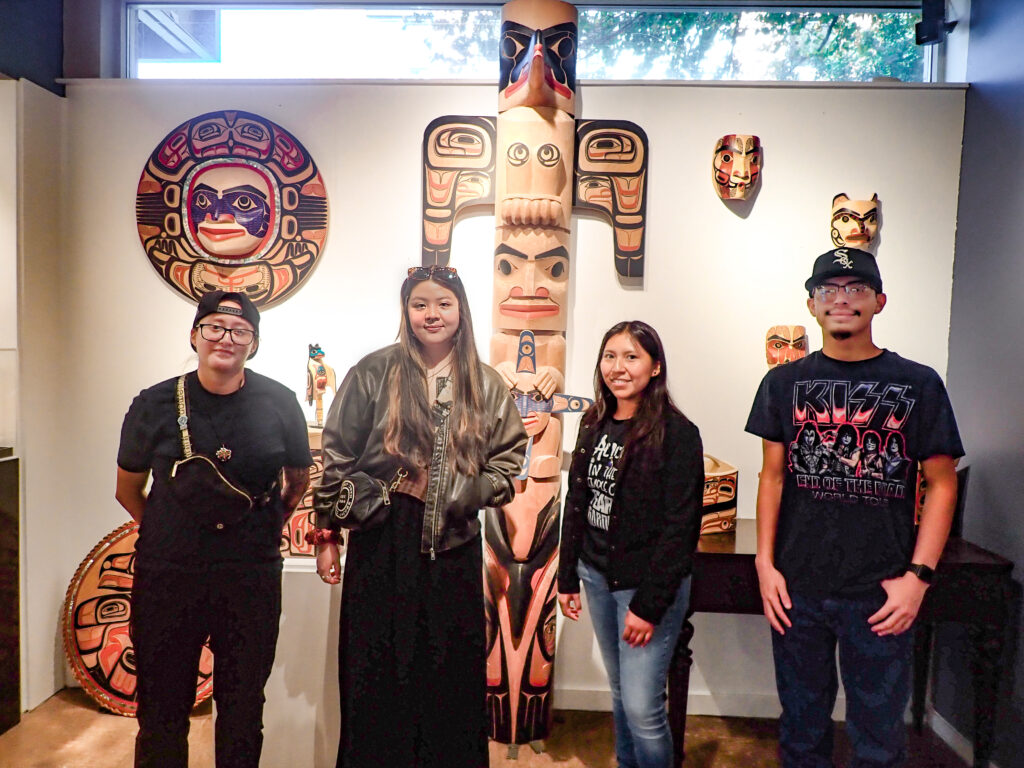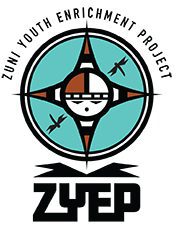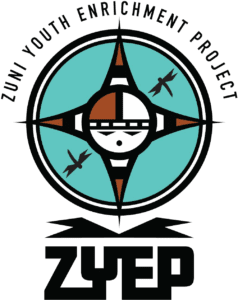ZUNI, NM (Oct. 20, 2025) — Three Zuni artists recently traveled to Seattle, Washington, as part of the Zuni Youth Enrichment Project’s Advanced Artist Apprenticeship Program. Supported by the Bezos Family Foundation, the five-day journey immersed them in Indigenous art, culture and advocacy beyond the Southwest; it also gave them a new perspective on their work, their identities, and their place in a broader national conversation about Native visibility and resilience.
ZYEP launched its Advanced Artist apprenticeship to elevate art students who have completed the youth project’s Emerging Artist Apprenticeship and are interested in continuing education. The program emphasizes artistic mastery, entrepreneurship, and leadership; it also highlights art as a powerful form of advocacy.
“In our beginners’ apprenticeship, youth learn foundational art skills, business basics, and cultural foundations,” said Tahlia Natachu-Eriacho, ZYEP’s executive director. “The advanced program is about going deeper and helping them understand how to share their stories with the world.”
To date, the art apprentices have presented and sold their work at regional art markets and cultural demonstrations across the Southwest. This fall’s trip to Seattle marked their first arts-related journey outside the region.
“We wanted our youth to experience how Native art and identity show up in other parts of the country,” Natachu-Eriacho explained. “The Southwest can bed a bit of a bubble. We wanted to get youth to other areas to experience how those places engage, or don’t engage, with Native art.
“We chose Seattle because it is a good example of an urban setting with many Indigenous nations, a strong arts community, and a vibrant culture of advocacy,” she added.
Exploring Seattle
From Sept. 22 to 26, advanced apprentices Cassandra Tsalate, 23 (natural clay traditional pottery), Mia Sutanto, 25 (2D graphic design), and Gregory Baca III, 19 (traditional embroidery and textiles) explored the city with Natachu-Eriacho and Kandis Quam, ZYEP arts leader. Their days were filled with discovery and reflection as they visited the Burke Museum, the Daybreak Star Indian Cultural Center, and several Indigenous-owned galleries, including Eighth Generation, Steinbrueck Native Gallery, and Tidelands Native Gallery.
“Everywhere we went, we saw how Native presence is woven into the city’s fabric,” Natachu-Eriacho recalled. “It was striking how much Indigenous influence and leadership there is, even more than when I lived there in 2017. The art students were surprised and inspired to see how visible Native cultures have become.”
Natachu-Eriacho attended college in the Pacific Northwest, earning a Bachelor of Arts degree in English from Western Washington University in Bellingham and a Master of Arts degree in education from Portland State University in Oregon. Quam said the region holds a special place in her heart, as well.
“As a college student, I went on a research trip with a small group of Indigenous Southwest students, interviewing and interacting with different Indigenous Northwest tribes,” she said. “That experience broadened my perspective on the world beyond my small village. It felt only right to give our art students a similar experience.”
The young artists enjoyed opportunities to compare how Native art and influence appear in both cultural institutions and everyday urban spaces. They expressed their gratitude for these opportunities—and for the knowledge and inspiration they could bring home.
“Being part of this trip was such an honor,” Baca said. “We were able to learn about art and cultures that are different from what we have around Zuni, which I thought was truly something special.”
Sutanto agreed, noting, “It was inspiring to see the work of relatives on the coast, and to see a thriving art scene away from home. It made me feel hopeful for the future and what we can do for the arts in Zuni.”
The art students and chaperones also visited iconic Seattle sites such as Pike Place Market and the Space Needle. Quam said she experienced a full-circle moment while eating breakfast in Pike Place; it was the same spot she enjoyed breakfast as a young student.
“There is so much that has changed in the city and the world since Tahlia and I had our individual experiences as fresh-off-the-reservation kids,” she explained. “Yet the experience remains so special, being a young adult in a vast urban environment for the first time without family.”
Outdoor adventures were part of the itinerary as well. The group hiked to Coal Creek Falls, watched the sunset at Alki Beach, and took a harbor cruise, all of which made a strong impression on the young artists.
“The homelands of the Northwest Coast Indigenous Peoples have a special place for us as A:shiwi (Zuni people),” Tsalate said. “Zuni has its connection to the ocean, forests and wildlife, and what I realized about seeing the art out there is the strong connection with the environment.”
She said the Seattle urban scene and the Pacific Northwest in general had an impact on their own artistic visions, and she and the other art students are reflecting on how meaningful their work is becoming with this experience.
“[It is] shaped by the environment, cultures, mentality, food, and even the music,” she explained. “They motivate our artistic lifestyles throughout our lifetime.”
Each evening, the group gathered for dinner and conversation. Discussions often centered on what they’d seen and how it related to their own creative journeys. According to Quam, one question lingered throughout the week: Is there a different mindset when making art for cultural purposes and making art to sell?
“That question led to some deep conversations,” Quam said. “They understood there’s a balance between honoring tradition and navigating the modern art world, and both can coexist beautifully.”
The trip culminated in a special presentation and lunch with the Bezos Family Foundation at its Seattle headquarters. There, the young artists shared their experiences, creative work, and reflections on what it means to be a Native artist today.
“I had a lump in my throat the whole time,” Natachu-Eriacho said. “I felt so honored and proud to witness them advocate for who they are and what they do. They demonstrated so much grace, and they embodied the values that we pray our people are rooted in.
“They also talked about the importance of this project in developing their skills as artists, their sense of belonging within the community, and their power and potential in the world,” she continued. “They reminded me of why we do this work.”
Accessibility and Transformation
For both Natachu-Eriacho and Quam, the trip reinforced the idea that art has the power to build confidence, community, and understanding. It also reinforced the importance of accessibility when it comes to youth arts programming.
“This opportunity was not something difficult to obtain,” Quam explained. “Did these students work incredibly hard before this trip? Of course they did. But they didn’t have to go to college, earn a scholarship, raise funds for tuition, and then be in the right place at the right time for the right people to look at them and say, ‘You are worthy.’
“For some, they saw a flyer, applied for a free program to learn a preferred art form, and then became part of the next generation of Zuni artists,” she continued. “From there, right within the village, they got cultural knowledge, technique, experience, validation, confidence, and encouragement.”
This is what makes ZYEP’s arts programming transformative. The students gain all of this within their own community, and then they can travel, experiencing how big the world is—and how much their voices matter within it.
What’s Next
The Seattle trip is part of a multiple-year initiative designed to expose young Zuni artists to diverse regions and creative communities across the country. The program’s next destination will likely be Boston, offering insight into how Native art and advocacy manifest in the eastern United States.
The project will conclude in 2026-27 with a final trip to Washington, D.C. While in the nation’s capital, art students will take a closer look at Native representation in national museums and public policy spaces.
“We want to provide guided, safe experiences where our young people can explore empowerment, adversity, and resilience,” Natachu-Eriacho said. “Through these journeys, they will be learning to use their art as a platform to share their stories, use their voices, and strengthen cultural understanding.”
To learn more about the Zuni Youth Enrichment Project and its programs, and for information about making donations, partnering with ZYEP, and volunteering, call (505) 782-8000 or visit zyep.org. And, to stay up to date on the latest news and events, follow the nonprofit youth organization on Facebook (/zuniyouthenrichmentproject), Instagram (@zuniyouthenrichmentproject), YouTube (/ZuniYouth), and TikTok (/zyep09).
Founded in 2009, the nonprofit Zuni Youth Enrichment Project is dedicated to promoting resilience among Zuni youth so they will grow into strong, healthy adults who are connected with Zuni traditions. ZYEP fulfills its mission by providing positive role models, enriching programs, and nurturing spaces that contribute to the healthy development of Zuni youth. ZYEP strives to provide every child with the encouragement and opportunities they need to reach their full potential.


